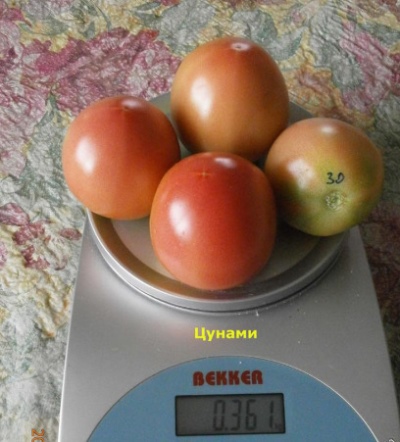
- Authors: Gavrish S.F., Morev V.V., Amcheslavskaya E.V. (LLC "Gavrish Breeding Firm")
- Year of approval: 1997
- Category: grade
- Growth type: indeterminate
- Appointment: fresh consumption
- Ripening period: mid-early
- Ripening time, days: 111-117
- Growing conditions: for film greenhouses, for greenhouses
- Bush size: medium-sized
- Bush height, cm: up to 150
There are few as formidable and majestic natural phenomena as tsunamis. The tomato named after him, of course, cannot come close to being as tall as the destructive walls of water. However, gardeners can achieve brilliant success if they study the characteristics of the plant well.
Breeding history
Gardeners owe the Tsunami tomato to the well-known firm "Gavrish". Such well-known breeders as Amcheslavskaya, Gavrish and Morev were involved in the project. They carried out breeding work in the most difficult period - in the first half of the 1990s. Permission to grow this crop in private gardens was given in 1997.
Description of the variety
Tsunami develops its bushes in an indeterminate pattern. They are medium-sized and can reach 1.5 m. Therefore, it is hardly worth being afraid of some extremely tall growth, which makes it extremely difficult to keep in a greenhouse. This variety is characterized by average branching and the same level of foliage. The light green leaves themselves are medium-sized and moderately corrugated; stipules are uncharacteristic for them.
The main qualities of the fruit
When the berries reach the desired ripeness level, they are pink in color. These large fruits weigh on average 295-315 g. Flat-round geometric shape is typical for them. The surface is either completely flat or includes underdeveloped ribs. The berries will be formed from simple inflorescences, and the first of them can be seen above the 9th leaf. Subsequent tomatoes develop every 3 leaves, and any of them - on an articulated stalk.
Taste characteristics
In the official description, the fleshiness of the Tsunami's flesh is noted above all. According to this indicator, the variety confidently challenges the leaders of consumer demand. Overall, it tastes sweet. No sour notes are mixed with the main impression.
Ripening and fruiting
The Tsunami tomato is considered a stable medium early variety. Usually from the appearance of the first green shoots to the appearance of the ready-to-harvest harvest, it takes from 111 to 117 days. But in some cases, this period changes predictably. Harvest in July. Sometimes this can be done in August as well.
Yield
In the description from the supplier of the planting material, the high fertility of the variety is indicated. On 1 bush, you can get 3 or even 3.5 kg of berries. Of course, the specific collection (and the quality of the berries) is largely in the hands of the farmers themselves.
The timing of planting seedlings and planting in the ground
Prepare containers with a substrate and use them for their intended purpose in March. If everything is done correctly, and no mistakes were made, it will be possible to get seedlings suitable for transshipment into open ground in May. However, the weather and the peculiarities of agricultural technology can greatly affect this indicator.

Growing tomato seedlings is an extremely important process, because it largely depends on whether the gardener will be able to harvest at all. All aspects must be taken into account, from seedbed preparation to planting in the ground.
Landing scheme
The most justified and recommended by the supplier is the 400x600 mm system.

Growing and care
An important role is played by intelligent selection of soil. You will probably have to experiment with this. During the growing season, it is necessary to apply mineral fertilizers. For seedlings, specialized soils and compost (which is pre-disinfected) are used. Seeds are sown in boxes with a step of 3 cm.
Additionally, it is necessary to fertilize the substrate with ash and minerals. The first shoots will have to be illuminated. Seedlings in the early stages of development are watered moderately. It is recommended to saturate the soil in the main place with organic and mineral additives before planting. Tsunami tomatoes are protected from excessive sunlight with breathable material.
There should not be more than 2 shoots on the bush. The withered foliage and stepchildren are cleaned strictly in the morning. Plant feeding is carried out with an interval of 10-11 days. Nitrogen fertilizers should be used with caution, and it is better not to apply at all. In the open air, hilling is important, which stimulates gas exchange.




A plant needs different micronutrients at each stage of growth. All fertilizers can be divided into two groups: mineral and organic. Folk remedies are often used: iodine, yeast, bird droppings, eggshells.
It is important to observe the rate and period of feeding. This also applies to folk remedies and organic fertilizers.
Disease and pest resistance
The susceptibility to tobacco mosaic is great. The likelihood of being affected by cladosporiosis is even higher. The official description indicates the average protection against fusarium wilting. The pests of this variety are the same as those of other tomatoes.


Growing regions
You can plant this tomato in:
Western Siberia;
most regions of the Far East and Eastern Siberia (except for the most severe);
North Caucasian and Ural regions;
regions and republics of the Volga region;
the European part of Russia.
Review overview
In assessments, many gardeners pay attention to the high productivity of this variety. Some argue that, as such, he has no flaws. At the same time, one cannot ignore the fact that sometimes they speak skeptically about germination and fertility. The early character of tomatoes is confirmed by everyone who tried to breed them. Differences in growing efficiency are likely to be attributed to special conditions and unequal skill.

























































































